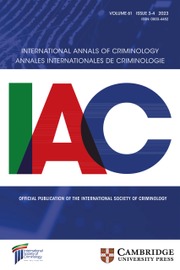No CrossRef data available.
Article contents
Evaluating the Efficacy and Constraints of DNA Evidence in the Criminal Justice System in India through Case Studies
Published online by Cambridge University Press: 03 November 2025
Abstract
DNA analysis, as part of forensic investigation, has transformed the criminal justice system by providing highly accurate evidence to link individuals to crime scenes, thereby enhancing forensic reliability while also increasing public trust in the system. However, its application in notable cases, such as the Nithari Kand and Aarushi Talwar cases, has revealed systemic weaknesses. These cases highlight the challenges of implementing DNA technology in underdeveloped forensic infrastructures, raising concerns about the consistency and reliability of forensic processes. The present study examines the efficacy and limitations of DNA analysis in criminal investigations in India, utilizing qualitative data from forensic experts (n = 8), investigating officers (n = 12) and legal professionals (n = 60), as well as forensic reports and court documents. We found that while DNA evidence played a critical role in victim identification and suspect linkage, its impact was often compromised by procedural lapses, sample contamination and delayed forensic processing. These findings contribute to the growing body of research on forensic science in developing legal systems and offer practical implications for reforming India’s forensic and investigative infrastructure.
Abstracto
El análisis de ADN, como parte de la investigación forense, ha transformado el sistema de justicia penal al proporcionar evidencia altamente precisa que vincula a las personas con las escenas del crimen, mejorando así la fiabilidad forense y aumentando la confianza pública en el sistema. Sin embargo, su aplicación en casos notables, como los de Nithari Kand y Aarushi Talwar, ha revelado debilidades sistémicas. Estos casos ponen de relieve los desafíos de la implementación de la tecnología de ADN en infraestructuras forenses poco desarrolladas, lo que genera inquietud sobre la consistencia y la fiabilidad de los procesos forenses. El presente estudio examina la eficacia y las limitaciones del análisis de ADN en las investigaciones criminales en la India, utilizando datos cualitativos de expertos forenses (n = 8), investigadores (n = 12) y profesionales del derecho (n = 60), así como informes forenses y documentos judiciales. Observamos que, si bien la evidencia de ADN desempeñó un papel crucial en la identificación de víctimas y la vinculación de sospechosos, su impacto a menudo se vio comprometido por fallos procesales, contaminación de muestras y demoras en el procesamiento forense. Estos hallazgos contribuyen al creciente corpus de investigación sobre ciencia forense en los sistemas jurídicos en desarrollo y ofrecen implicaciones prácticas para la reforma de la infraestructura forense e investigativa de la India.
Abstrait
L’analyse ADN, dans le cadre des enquêtes médico-légales, a transformé le système de justice pénale en fournissant des preuves extrêmement précises permettant de relier des individus aux scènes de crime, améliorant ainsi la fiabilité des analyses et renforçant la confiance du public dans le système. Cependant, son application dans des affaires notables, telles que les affaires Nithari Kand et Aarushi Talwar, a révélé des faiblesses systémiques. Ces affaires mettent en évidence les difficultés de mise en oeuvre de la technologie ADN dans des infrastructures médico-légales sous-développées, suscitant des inquiétudes quant à la cohérence et à la fiabilité des processus médico-légaux. La présente étude examine l’efficacité et les limites de l’analyse ADN dans les enquêtes criminelles en Inde, en utilisant des données qualitatives provenant d’experts médico-légaux (n = 8), d’enquêteurs (n = 12) et de juristes (n = 60), ainsi que des rapports médico-légaux et des documents judiciaires. Nous avons constaté que si les preuves ADN jouaient un rôle essentiel dans l’identification des victimes et le lien avec les suspects, leur impact était souvent compromis par des lacunes procédurales, la contamination des échantillons et des retards dans le traitement médico-légal. Ces résultats contribuent au corpus croissant de recherches sur la science médico-légale dans le développement des systèmes juridiques et offrent des implications pratiques pour la réforme de l’infrastructure médico-légale et d’enquête de l’Inde.
摘要
DNA分析作为法医调查的一部分,通过提供高度精确的证据将个人与犯罪现场联系起来,彻底改变了刑事司法系统,从而提高了法医的可靠性,也提升了公众对该系统的信任。然而,在尼塔里·坎德案和阿鲁希·塔尔瓦尔案等著名案件中,DNA分析的应用暴露出系统性缺陷。这些案件凸显了在欠发达的法医基础设施中应用DNA技术的挑战,引发了人们对法医流程一致性和可靠性的担忧。本研究利用来自法医专家(n = 8)、调查人员(n = 12)和法律专业人士(n = 60)的定性数据,以及法医报告和法庭文件,探讨了DNA分析在印度刑事调查中的有效性和局限性。我们发现,虽然DNA证据在受害者身份识别和嫌疑人联系中发挥了关键作用,但其效力常常因程序失误、样本污染和法医处理延迟而受到影响。这些发现促进了法医学在发展中法律体系中日益增长的研究,并为改革印度的法医学和调查基础设施提供了实际意义。
ملخص
أحدث تحليل الحمض النووي، كجزء من التحقيقات الجنائية، نقلة نوعية في نظام العدالة الجنائية من خلال توفير أدلة دقيقة للغاية لربط الأفراد بمسارح الجريمة، مما عزز موثوقية الأدلة الجنائية وعزز ثقة الجمهور بالنظام. ومع ذلك، كشف تطبيقه في قضايا بارزة، مثل قضيتي نيثاري كاند وأروشي تالوار، عن نقاط ضعف منهجية. تُبرز هذه القضايا تحديات تطبيق تقنية الحمض النووي في ظل تخلف البنى التحتية للطب الشرعي، مما يثير مخاوف بشأن اتساق وموثوقية عمليات الطب الشرعي. تدرس هذه الدراسة فعالية وقيود تحليل الحمض النووي في التحقيقات الجنائية في الهند، مستخدمةً بيانات نوعية من خبراء الطب الشرعي (عددهم 8)، وضباط التحقيق (عددهم 12)، والمهنيين القانونيين (عددهم 60)، بالإضافة إلى تقارير الطب الشرعي ووثائق المحاكم. وقد وجدنا أنه على الرغم من الدور الحاسم الذي لعبته أدلة الحمض النووي في تحديد هوية الضحايا وربط المشتبه بهم، إلا أن تأثيرها غالبًا ما كان متضررًا بسبب الثغرات الإجرائية، وتلوث العينات، وتأخر معالجة الأدلة الجنائية. تُسهم هذه النتائج في إثراء البحث المتنامي حول الطب الشرعي في تطوير الأنظمة القانونية، وتُقدم انعكاسات عملية لإصلاح البنية التحتية للطب الشرعي والتحقيق في الهند.
Keywords
Information
- Type
- Article
- Information
- Copyright
- © International Society of Criminology, 2025

